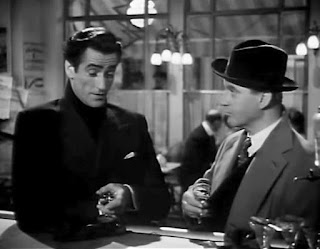Directed by Robert Hamer; produced by Aubrey Baring
A daring bank robbery late at night in 1913 France has the government outraged, but Fernand Maubert (Eric Portman), director of the detective police, knows who is responsible: master-thief Philippe Lodocq (Guy Rolfe). The two men have battled each other previously, Lodocq sometimes getting away with his crimes, Maubert sometimes putting him in prison. Maintaining their respect for each other, as well as a polite kind of contempt, they find a new bond - and rivalry - in Lodocq’s new accomplice, the beautiful Madeleine Saincaize (Nadia Gray). And on the eve of the Great War, the two men may find their latest encounter their last.
A well-written drama, The Spider and the Fly is part crime thriller and part character study. The game the two leads play against each other is serious and multi-faceted. The lines each speaks to the other are often on at least two planes at once as they try to intimidate each other, and search for each other’s weaknesses. Yet at the same time, they are quite honest with each other - in their own fashion. One feels that Maubert genuinely thinks that Lodocq’s life of crime is a waste of a good man, a gentleman, who should have aspired to something better, while Lodocq scoffs at Maubert’s plodding, almost parochial life.
The acting is very good, particularly by the two leads. Their solemnity may seem incongruous compared to some of the comic relief thrown in from time to time (comic actor Arthur Lowe beginning his career as a town clerk; Sebastian Cabot (Mr French of tv’s A Family Affair) as a provincial policeman) but I think this reflects the seriousness with which they live their lives. Maubert is shown unbending in several brief scenes - when he has reason to.
The story has several levels, too, like the characters. Seemingly a cops-and-robbers story, it involves romance and personality, politics and warfare. It’s the sort of movie that could have made a tv series, as long as the original writer (in this case, Robert Westerby) stayed throughout its run. As well, the romantic elements don’t go where one might expect, and the conclusion is an ironic twist. As for the love-triangle, viewers will very likely not guess with whom Gray ends up leaving at the end.
The Spider and the Fly is not a classic but is very good, with solid writing, acting and directing. The setting in France lends an air not found in British or American settings and the writer knows how to incorporate small touches to make the Gallic location add to the film, while the players know how to display those touches. All in all, this is a movie that deserves to be remembered more than it has been.



























